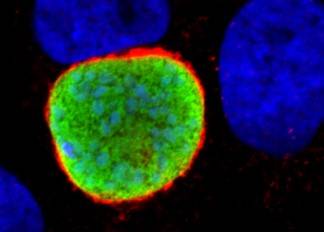
DURHAM, N.C. -- In the search for new weapons against malaria, most drug development has focused on the parasites that cause the disease. But Duke University researchers are trying a different tack. Instead of targeting the malaria parasite directly, the idea is to discover drugs aimed at the human cell machinery conscripted to do malaria's dirty work.
In a new study, a team led by assistant professor of chemistry Emily Derbyshire has identified more than 100 human genes that malaria parasites commandeer to take up residence inside their victim's liver during the 'silent' earlier stages of infection, before symptoms appear.
Before their work only a few such genes were known. The findings could eventually lead to new ways to stop malaria parasites before people get sick and help keep the disease from spreading, via treatments that are less likely to promote resistance than existing malaria drugs, the researchers say.
The study appeared online June 27 in the journal Cell Chemical Biology.
Malaria is caused by Plasmodium, a single-celled parasite spread through the bites of infected mosquitoes. Within hours of entering a person's body, the parasite finagles its way into a liver cell, which it uses as a sort of living nursery. There, it steals bits of the host's cell membrane to help build a protective pouch inside the cell where it quietly matures and multiplies before bursting out by the thousands into the bloodstream.
That's when the parasite starts to invade red blood cells and cause malaria's characteristic waves of fever and chills. The blood stage is also when parasites can be picked up by another biting mosquito and transmitted to the next person. If we could stop the parasite while it still lurks in the liver, before it reaches the blood, researchers say, we could keep people from developing symptoms or contributing to its spread.
For this study, researchers used snippets of silencing RNA to trick human liver cells into tamping down each of roughly 7,000 protein-coding genes. Then they infected the liver cells with a mouse malaria parasite similar to the Plasmodium species that causes human malaria. The researchers looked to see if, by preventing the cells from making a given protein, they could reduce the parasite load within the liver without killing the liver cells themselves.
The researchers identified over 100 human genes that malaria co-opts for its own benefit as it develops inside the liver, including several involved in carrying cargo between different cell compartments that the team is investigating further. Drugs that suppress some of these targets could potentially stunt the parasite's development before it runs rampant in the blood, the researchers say.
Drugs to prevent and treat malaria have been around for centuries. And yet worldwide the disease still kills about 500,000 people a year, in part because parasite populations have developed ways to evade attack.
"Many of the drugs that are available aren't working very well because of resistance," Derbyshire said.
Some say the only way to stay ahead is to keep finding new drugs. The early liver stage is seen as a promising target because people harbor fewer parasites at that point, which could slow the rise of resistance.
"Even though tens of thousands of parasites come out of the liver, that's still a very small number compared to the billions that build up later in the blood stage," said co-first author Maria Toro-Moreno, a chemistry graduate student at Duke.
This choke point could make for an easier target, Toro-Moreno explained. "It's a population bottleneck. The parasite is vulnerable at this stage."
Lower numbers also mean the parasites in an infected person's body are less genetically diverse. A drug administered at this stage is less likely to promote resistance than one administered after Plasmodium has multiplied more, during which time random genetic mutations could arise that enable some parasite strains to survive treatment.
Identifying potential targets is just a first step in drug development, a process that can take over a decade and require millions of dollars of investment before reaching the clinic. But by better understanding the intimate relationship between the malaria parasite and its host, the researchers hope to get closer.
This research was supported by the National Institutes of Health (DP2AI138239, F32AI118294) and the Duke Translational Research Institute Pilot Program.
CITATION: "Discovery of Druggable Host Factors Critical to Plasmodium Liver-Stage Infection," Rene Raphemot, Maria Toro-Moreno, Kuan-Yi Lu, Dora Posfai and Emily R. Derbyshire. Cell Chemical Biology, June 27, 2019. DOI: 10.1016/j.chembiol.2019.05.011






